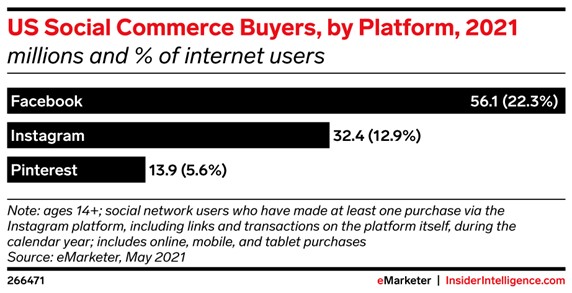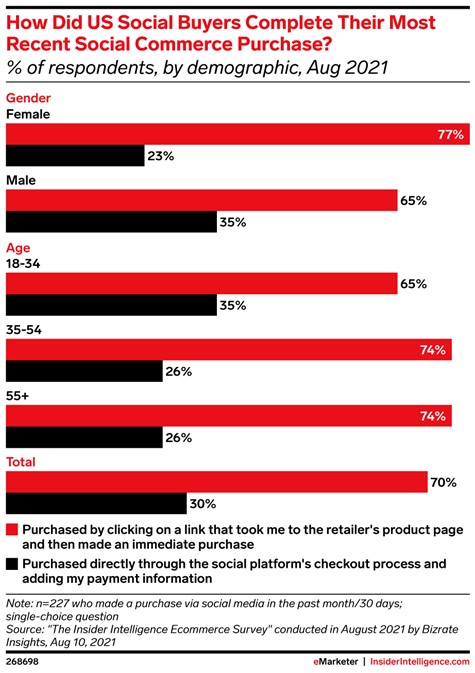
27 Oct A Guide to Social Media Shopping Behaviors in 2021
Social commerce has significantly evolved over the last few years. From 2020-2021, there was a 35.5% increase in retail social commerce sales, a trend that’s expected to continue to grow in the coming years.
It’s evident that with the plethora of shoppable features available across social networks, audiences are beginning to take advantage. That said, it’s important to know which social commerce features are the most popular, which networks audiences are more likely to purchase from, and most importantly, how people are actually purchasing products.
Read on to understand the current state of consumer shopping behaviors on social media and how to best optimize your social commerce strategy.
Social Shopping Features Available
In 2021, digital buyers in the United States grew by 1.32 percent. That’s over 230 million online shoppers. Of course, the main cause of this growth was the global pandemic that prevented consumers from being able to enter brick and motor locations, thus, taking up more online shopping habits.
The increased digital shopping activity led the social media networks to ramp up their social commerce game, and now each of the major players provides multiple opportunities for audiences to purchase products.
We’ve broken down a full guide to shoppable features on social media here, but below are a few social commerce trends we’re seeing emerge.
- Digital Storefronts for Direct Purchases
Nearly every social network has its own version of a digital storefront for users to browse, place orders, and even make purchases directly within the app. Facebook and Instagram have taken it a step further and are launching shoppable ad units as well.
- Livestream Shopping
Major networks such as Facebook, Instagram, TikTok, and now YouTube, have all enabled Livestream shopping capabilities that allow audiences to view products, save items, and make purchases all while viewing a live video on the networks.
- AR Integrations
While Augmented Reality (AR) is most utilized in the form of lenses and filters today, many social networks are experimenting with ways to leverage AR for eCommerce. Audiences will soon be able to scan real-life items and then browse and purchase products like those items scanned.
Popular Networks for Social Shopping
While every network now has shopping capabilities, knowing which networks audiences are more likely to purchase from can help you narrow your focus. In the US, it’s no surprise that Facebook takes the lead with 22.3% of internet users (ages 14+) making at least 1 purchase from the platform within the calendar year. As seen in the chart below, Instagram and Pinterest follow.
This could drastically change in the coming months though. Not only is Facebook dealing with some rather serious allegations and internal issues, but newer networks that have only just rolled out social commerce capabilities could quickly catch up over the holiday season.
How Purchases Are Made on Social
The most important aspect of social commerce that we need to understand is, are audiences more likely to purchase directly on social networks? The answer is… not yet. As you can see from the eMarketer chart below, only 30% of respondents made purchases directly through the social platform checkout processes. The other 70% instead clicked through to purchase items directly from the retailer’s website.
It’s evident that consumers are still hesitant to enter their personal and financial information on social platforms, but there’s still hope that this will change in the coming years. Looking at the same eMarketer data, younger generations (Gen Z and Millennials) are more likely to make purchases directly on the platform.
Key Takeaways For Your Brands Social Commerce Strategy
Now that we have a better understanding as to what social media shopping behaviors are most popular, here are some opportunities for brand optimizations.
- Setup Digital Storefronts. If your brand is active on at least Facebook and Instagram, get those Facebook Shops and Instagram Shops set up. If you’re on other channels as well, it doesn’t hurt to get set up there too. These shops make your products easier to discover AND easier to purchase. Plus, if you have a media budget you can run ads directly to your shops.
- Keep the “View on Website” Option Available. Don’t put all your eggs in one basket and assume people are going to purchase directly on the social network. We saw in the data above that the majority of people are still going to websites for purchase, so make sure that option is there. Note: Drive audiences to your brand website (versus an Amazon shop) for retargeting purposes.
- Keep the User Experience Simple. For those audiences going to your website, make sure you’re sending them directly to the respective product page and that as much information is included on that page as possible – most importantly the “buy now” button. Pictures, reviews, product descriptions and more will help audiences feel more comfortable with their purchase. Same goes for the social shopper – if you can include reviews and multiple images in your product showcase, do it.
- Run Tests. If you have the opportunity and budget, run tests to see what actions your specific audience is more willing to take. Then you can adjust the messaging of your content/ads to reflect the results and push people down the path to purchase in a more effective manner.
- Don’t Forget About Retargeting: Not everyone is making a purchase instantly. Depending on the nature of your product, audiences may need some time to evaluate their investment before hitting “buy now” (especially high-priced items). Make sure you’re retargeting audiences who are viewing your digital storefronts and visiting product pages to help bring people back to purchase.
- Look-a-Likes for the Win: If you want to get in front of more people similar to those who are already viewing/purchasing your products, get those look-a-like audiences set up! This is a great way to not only get more people interested in your product, but these audiences are more likely to purchase than traditional targeting methods.
We’ll be keeping an eye on how these social media shopping trends continue to evolve heading into the 2021 holiday season. That said if your brand is looking for an agency to help optimize your social commerce strategy before then or heading into the new year, contact us today.
Also, keep yourself up to date on all things social media related by subscribing to our e-newsletter below.









